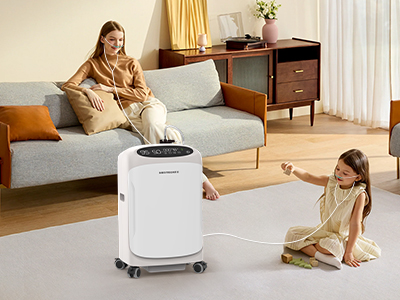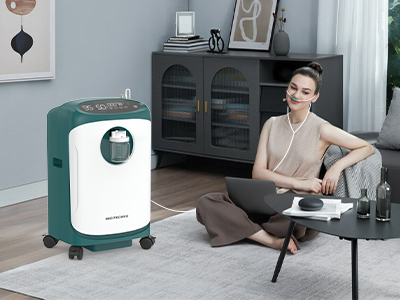17 Jan 2025
For many people, the journey with oxygen therapy starts as a medical necessity. However, as life continues, it becomes an integral part of daily living. Oxygen therapy is no longer confined to hospital rooms or clinical settings. It finds its place in everyday life, accompanying individuals through routine tasks, social events, and even personal moments of rest.

Oxygen Therapy and Routine Activities
One of the most significant aspects of living with oxygen therapy is seamlessly integrating it into everyday tasks. For individuals accustomed to managing their condition, the act of wearing an oxygen mask or nasal cannula while cooking, cleaning, or managing other household chores becomes second nature. Rather than seeing the therapy as a burden, it transforms into a helpful tool that ensures continued independence. With the right oxygen delivery system, people can move freely around their homes, attending to responsibilities without missing a beat.
Socializing with Oxygen Therapy
Social interactions can often pose challenges for those who require supplemental oxygen. However, with proper planning and preparation, individuals can continue to socialize and enjoy gatherings. Oxygen therapy no longer has to feel like an obstacle at parties, family events, or outings. It’s about finding strategies to manage the equipment, like using portable oxygen concentrators or even discreet accessories that don’t hinder the experience. Being comfortable and open about one's needs can lead to more fulfilling social lives. Support from friends and family further enhances the experience, turning potential social discomfort into a shared understanding.
Staying Active and Mobile
One of the most empowering aspects of oxygen therapy is that it doesn’t need to confine you to the indoors. Many people with chronic respiratory conditions fear that oxygen therapy will limit their mobility. However, portable oxygen devices have revolutionized the way individuals maintain physical activity. Whether it’s a stroll in the park or a more rigorous workout, oxygen therapy supports stamina, making movement more accessible. Adapted physical activities, like yoga or low-impact cardio, can also be pursued while using oxygen. Staying active promotes overall health and helps manage chronic conditions, improving both mental and physical well-being.
Traveling with Oxygen Therapy
Traveling with oxygen may seem daunting, but it’s entirely feasible with the right preparation. Whether taking a road trip, flying across the country, or navigating public transportation, oxygen users can maintain their mobility and freedom. A portable oxygen concentrator (POC) offers an efficient way to stay oxygenated on the go, allowing for flexibility in travel plans. For air travel, planning ahead is key: airlines have specific guidelines regarding oxygen use onboard, including required documentation and equipment restrictions. Long vacations or weekend getaways are also possible, as accommodations and transport options are increasingly designed to support oxygen therapy users.

Sleep and Rest with Oxygen Therapy
Getting quality sleep is essential for overall health, but for those using oxygen therapy, it can require some adjustments. With the right setup, such as an oxygen concentrator that is silent and unobtrusive, it’s possible to have a restful night. Many people find that they wake up feeling more refreshed and energized after a night of proper oxygen supplementation. Sleep disorders like sleep apnea, which can be exacerbated by low oxygen levels, can be effectively managed with continuous oxygen therapy. This, in turn, contributes to better energy levels during the day, fostering a sense of normalcy and vitality.
Emotional Well-being and Oxygen Therapy
Living with oxygen therapy can evoke a range of emotions. Initially, there may be feelings of frustration, embarrassment, or even sadness as individuals adjust to a new routine. However, as therapy becomes part of daily life, these emotional hurdles often diminish. Psychological resilience is critical, and seeking support through therapy, support groups, or talking with loved ones can significantly improve emotional well-being. Over time, patients realize that oxygen therapy doesn’t define them—rather, it supports their ability to live life to the fullest. Embracing this shift in mindset is key to maintaining a positive outlook.
Safety Measures for Oxygen Users in Daily Life
While oxygen therapy enhances life, it’s essential to adhere to safety precautions to avoid risks. Proper handling and storage of oxygen equipment are critical to preventing accidents, including fires. Keeping oxygen tanks away from heat sources, open flames, and combustible materials is crucial. Ensuring that oxygen concentrators are in well-ventilated spaces and free from obstructions also helps ensure smooth operation. Routine cleaning and inspection of equipment also prevent malfunctions. These precautions, though simple, ensure that individuals can safely continue using oxygen without unnecessary concern.
Oxygen Therapy and Independence
The true benefit of oxygen therapy is the ability to regain independence. While it requires adjustments, it ultimately empowers individuals to continue living fulfilling, autonomous lives. Many patients report that, once they adjust to their oxygen equipment, they feel more in control of their daily routines. Oxygen therapy can be the bridge between living a restricted, dependent life and embracing freedom. It provides the necessary support to continue enjoying hobbies, social events, and other aspects of life that are essential for personal fulfillment.
Conclusion
Oxygen therapy isn’t merely a medical necessity—it’s an essential tool that integrates into the fabric of everyday life. By adapting to its presence in various aspects of life, individuals can lead more active, independent, and fulfilling lives. Oxygen therapy allows users to remain involved in their communities, pursue their passions, and experience emotional well-being. Through thoughtful integration, oxygen therapy becomes an enabler of life, rather than a limitation. The journey of adjusting to oxygen therapy may take time, but it holds the potential for a transformative and enriching experience.
Keywords: oxygen therapy
Originally published 17 Jan 2025, updated 17 Jan 2025.